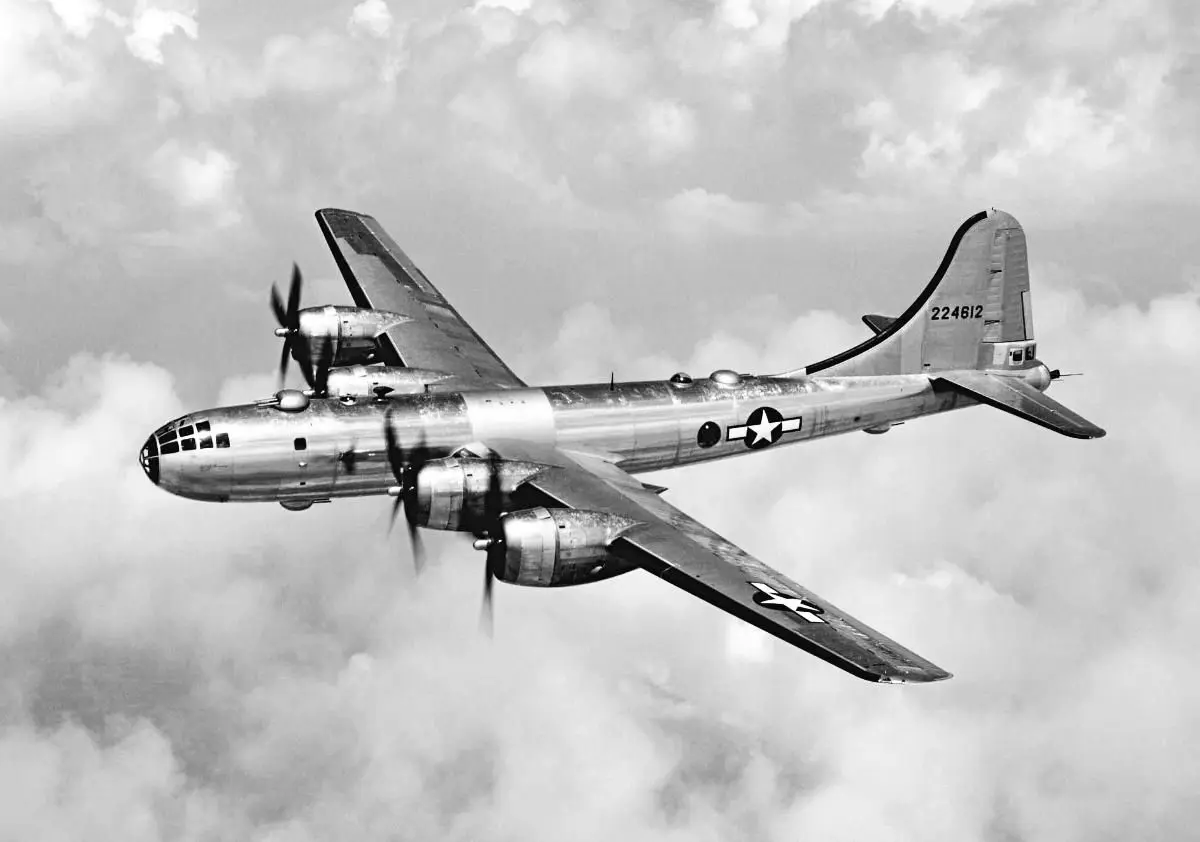
How Many B-29 Are Still Flying?
Boeing built almost 4000 B-29 Superfortress bomber aircraft. But how many are still flying today?
Table of Contents
The Boeing B-29 Superfortress is the iconic bomber aircraft that ended World War II. Some are actually still airworthy but how many B-29 are still flying? We'll take a look and tell their story.
Able to fly higher and faster than the enemy, the Boeing B-29 proved to be a very capable and effective bomber during World War II and the Korean War. It featured state-of-the-art technology at the time and was the most expensive design and production program of World War II. It retired from service in 1960.
Even though Boeing built almost four thousand B-29s, only a few remain today. And few of them are airworthy. So how many B-29 are still flying?
About the Boeing B-29 Superfortress
The Boeing B-29 Superfortress was a 4-engine, propeller-driven bomber aircraft, designed and manufactured by Boeing and used by the United States between 1944 and 1960. Additionally, the B-29 was one of the most advanced aircraft in World War II and featured state-of-the-art technology at the time.
For example, it was the first allied bomber to have a pressurized cabin. The B-29 Superfortress also featured a unique analog computer-controlled gun firing control system which allowed the crew to remotely operate some of the defensive turrets on board. When it entered service in 1944, it was one of the largest aircraft in World War II, only surpassed by the Messerschmitt ME 323 Gigant.
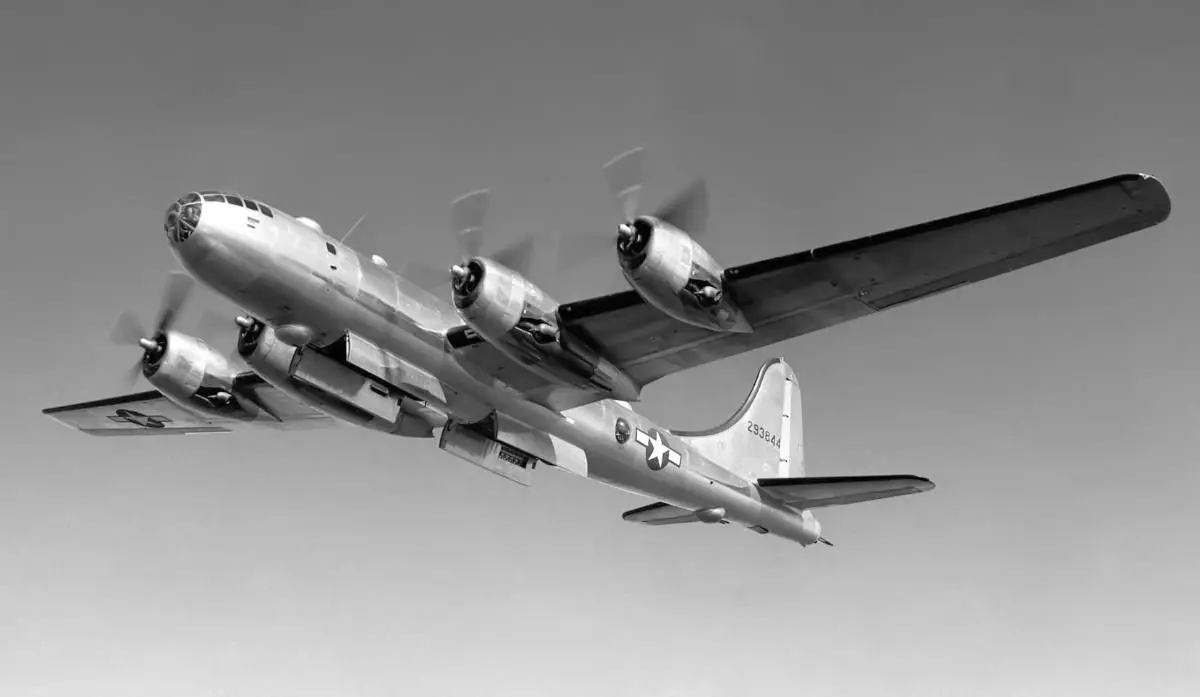
Because of the advanced design, the B-29 Superfortress became the most expensive production program during World War II. Total development and production cost amounted to $3 billion, equal to about $43 billion today.
For that money the United States got a very versatile aircraft that stayed in service for many years after World War II, serving in various roles. But during World War II, the B-29 Superfortress became especially known for dropping the atomic bombs over Hiroshima and Nagasaki. That makes the B-29 the only aircraft ever to have dropped nuclear weapons in combat.
A Master in Defending Itself
Boeing designed the B-29 for high-altitude, strategic bombing. But it also excelled in lower altitude night bombing missions and proved very capable of dropping mines. The B-29 Superfortress also flew higher and faster than Japanese fighter aircraft. As a result, few enemies could reach the 31.850 feet (9.710 m) that the B-29 would cruise at. Those few that did had trouble keeping up with its high speed of 350 mph (560 km/h).
Only the most powerful and heavy anti-air defense weapons could reach it. However, the Axis forces did not have the right equipment so the B-29 proved to be difficult to take down.
The highly advanced design proved to be quite a headache during production. Engineers implemented design changes very often. In early 1944 Boeing brought new aircraft directly from production lines to modification facilities for major rebuilds. The trouble also became very clear in early 1943. At that time, Boeing had built over 100 aircraft. Only 15 of them could fly.
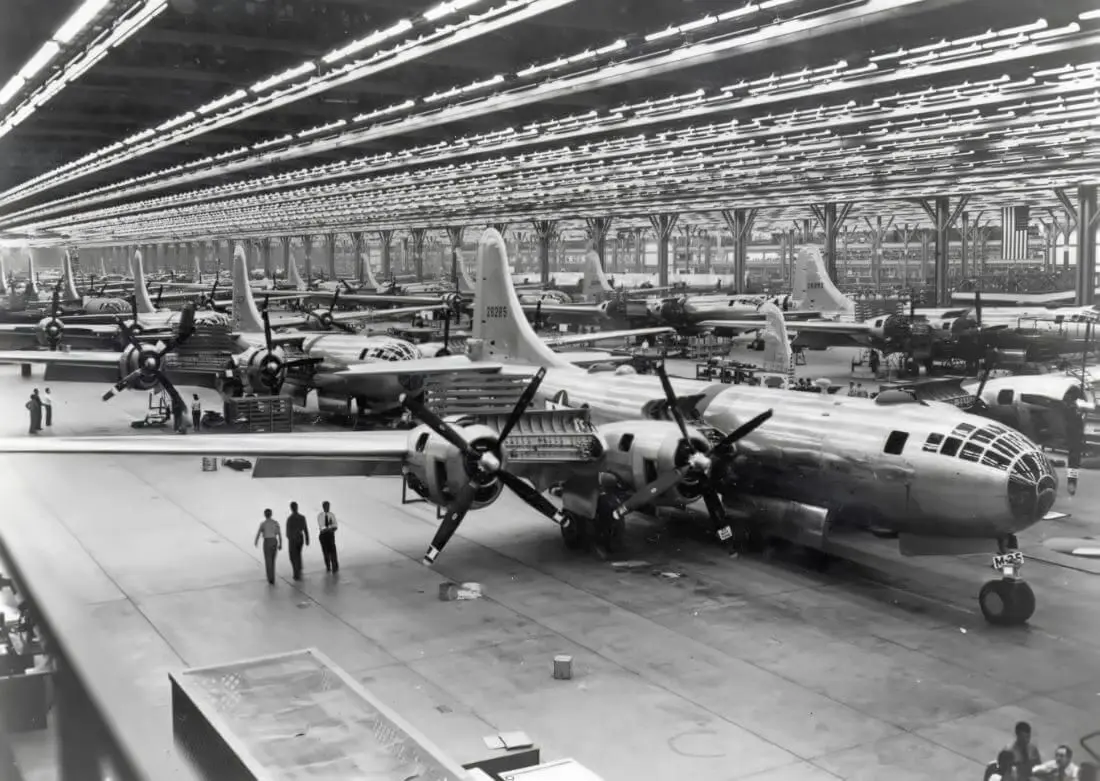
Despite the initial hiccups, the Boeing B-29 Superfortress overcame the troubles. Boeing had built a total of 3.970 units when it retired in 1960. The initial purchase order for the Boeing B-29 Superfortress was for 250 aircraft.
How Many B-29's Are Still Flying?
Boeing had manufactured a total of 3.970 units of the B-29s when production ended in 1946. When it retired from service in 1960 it had served a crucial role in both World War II and the Korean War.
Immediately after retirement, the Air Force used some B-29s for target practice and training. But the majority of the B-29s went into storage. However, heat and moisture damaged many of the B-29s in storage and between 1946 and 1949 a large number were scrapped.
Because of the rapidly diminishing numbers, in 1966 many considered the Boeing B-29 Superfortress an extinct aircraft except for two at museums. In the following years though, interest grew for finding and recovering examples of the B-29 for exhibitions and museums. Since the early 1970s, many B-29s were recovered and restored for museums. The last B-29 was recovered in 2000.
Today, only 26 Boeing B-29 Superfortress remains in complete shape.
How many B-29 are still flying? Out of the 26 surviving B-29s, only two are airworthy today and able to fly.
They are called FIFI and Doc.
"FIFI"
One of the two B-29s still flying is "FIFI". It is owned by the Commemorative Air Force and is based at the Vintage Flying Museum in Fort Worth, Texas. FIFI tours the United States and Canada every year and is part of air shows where it offers rides.
Boeing had built FIFI in 1944 and delivered it to the USAAF in 1945. It retired from service in 1958 and was put in storage at Naval Air Weapons Station China Lake in California. In storage, the Air Force used FIFI for missile target practice and was further damaged by heat, sand, and vandalism.
In 1966, the newly founded Commemorative Air Force was looking to obtain examples of all Word War II bomber aircraft, including the B-29 Superfortress. Members of the CAF found the B-29 at China Lake in 1970. After a year of extensive negotiations and paperwork with the owner, the US Air Force, CAF was able to acquire FIFI in 1971.
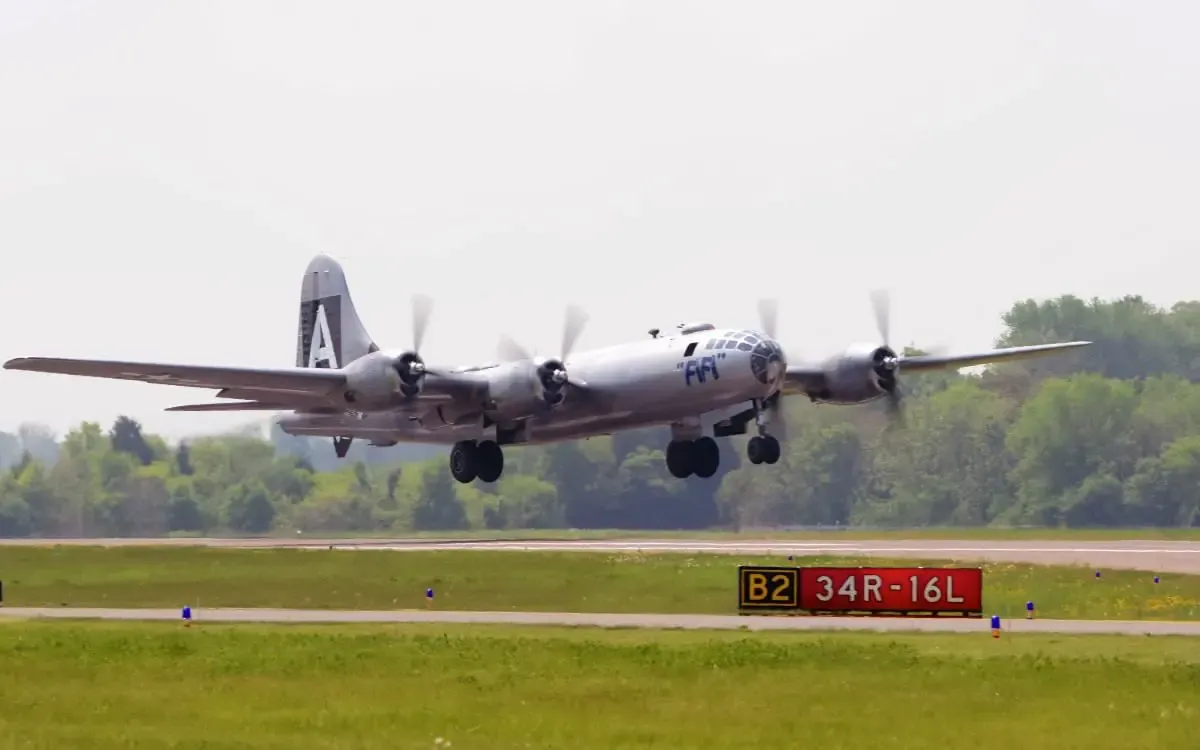
So the CAF put together a team of technicians and volunteers. They arrived at China Lake to restore FIFI to airworthy condition. In only nine weeks they managed to do the job. The work involved a thorough restoration of all systems and replacing hoses for hydraulics, fuel, and oil. The team had to cannibalize parts from other nearby B-29s, while other spare parts were manufactured specifically for the job.
After a successful test of the engines and landing gear, FIFI was once again ready to fly on August 3, 1971. The team had obtained a single one-trip flight permit to ferry the B-29 out of China Lake to the CAF headquarters in Harlingen, Texas. The trip went smoothly without incidents.
Now the "real work" began towards the complete restoration of FIFI. It required much work and fundraising and took three years. After restoration was complete, the CAF named their B-29 "FIFI".
Since then, the CAF has kept FIFI in the air with the help of volunteers. FIFI has appeared at many air shows around the world. Besides air shows, FIFI has also appeared in several movies through the years. It features in an episode of the TV series Better Call Saul.
"Doc"
The other Boeing B-29 Superfortress still flying today is Doc.
Doc was manufactured in 1944 and delivered to the USAAF in 1945. It never saw combat but was rebuilt into a radar calibration aircraft in 1951. The USAAF had it based at Griffiss Air Force Base in New York. Here, the squadrons named it after one of the characters from the Disney movie Snow White and the Seven Dwarfs. All squadrons named their B-29s in this manner.
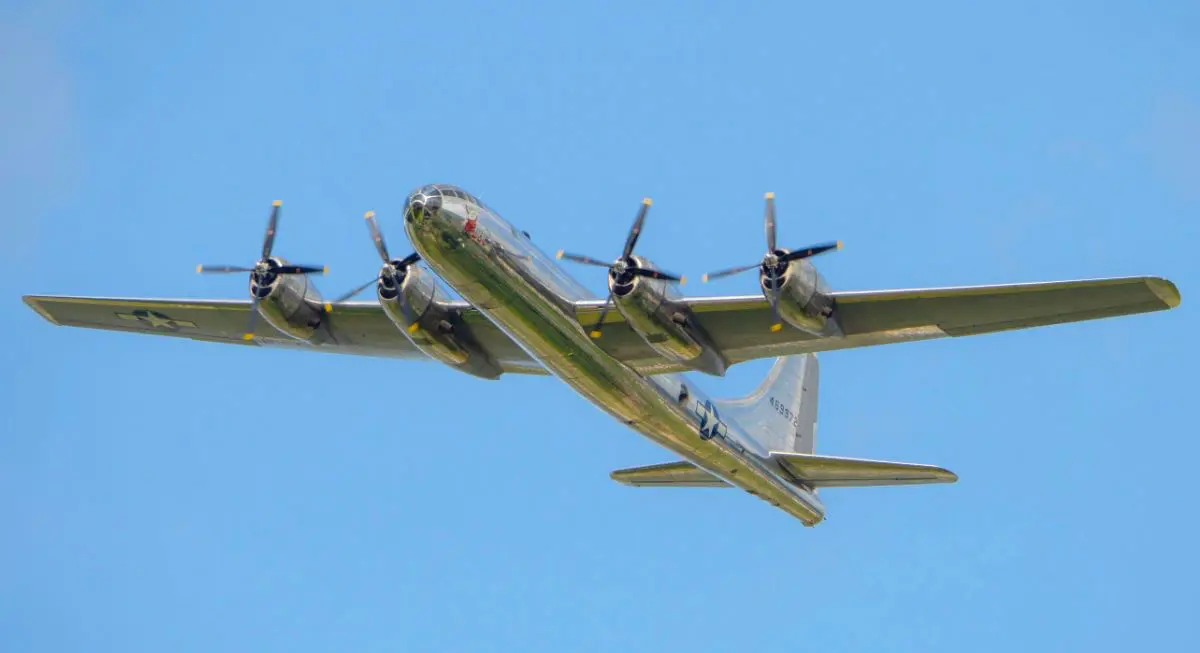
In 1955, the Air Force reassigned Doc as a target tug. A year later it became a target for bomb training at China Lake in California - The same place where the CAF found FIFI.
After sitting in the desert for decades, Doc was found in 1987 by Tony Mazzolini, a former US Air Force flight engineer whose passion was to fuel the restoration of Doc. However, it would take another 11 years for him to be able to pull Doc out of the desert.
After 42 years in the desert, Doc was towed out in 1998 and brought to the same factory where Boeing built it more than 50 years before. In the following 18 years, hundreds of volunteers put around 300.000 hours of work into bringing Doc into the skies once again. Assisted by Boeing and Spirit AeroSystems, the restoration team slowly resurrected Doc. Several components like wing spars, avionics, cables, and plexiglass windows needed replacements, just to name a few. Even the four engines were completely replaced by more reliable custom versions of the original Wright R-3350 Cyclones.
Eventually everything came together in 2016 where decades of hard work paid off. For the first time since 1956, Doc flew again, piloted by members of the FIFI crew. Doc appeared at its first airshow a year later, in 2017, and has been doing so ever since.
Today, Doc is owned by Doc's Friends, a non-profit organization based in Wichita, Kansas.
An Icon Through War and Peacetime
Out of the 3.970 Boeing B-29 Superfortress built, only 26 known aircraft have survived to this day.
Of those 26, only two are still flying.
Thanks to countless hours of hard, passion-driven work, "FIFI" and "Doc" was saved from the destructive desert heat and brought back into the air again. Today you can experience both B-29s at airshows where they often offer visitors a ride.
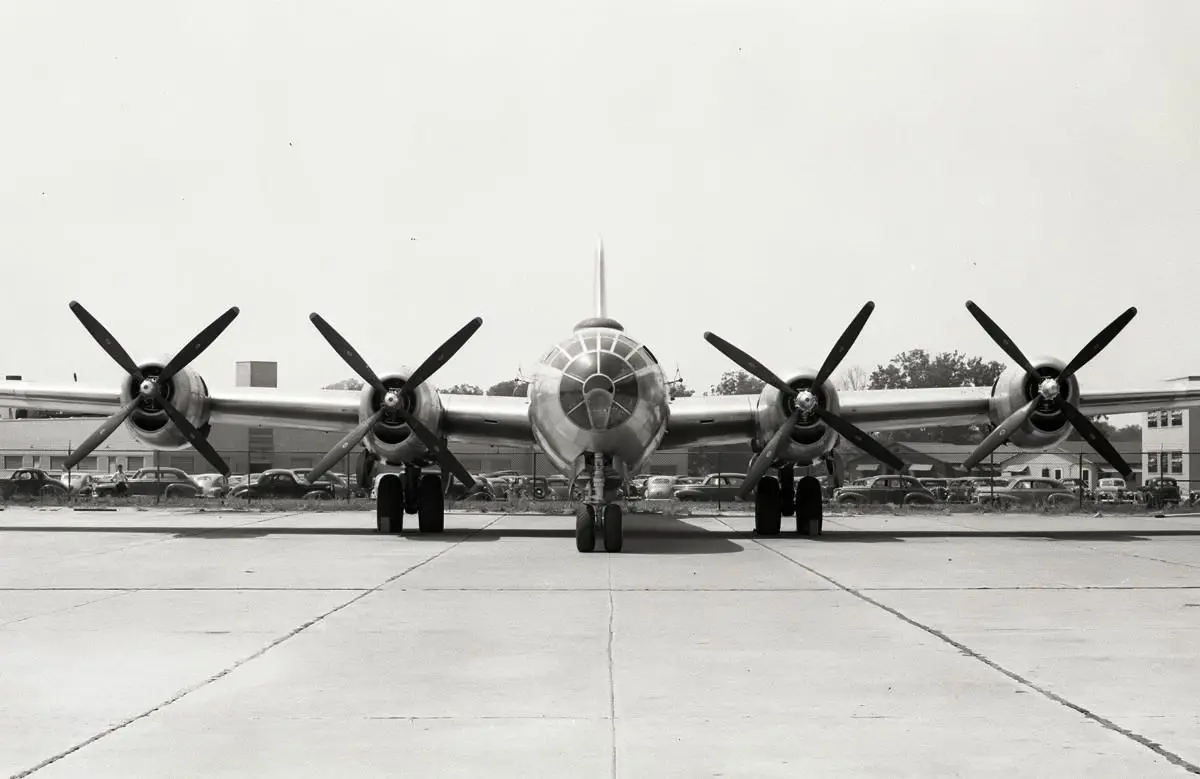
The Boeing B-29 Superfortress was one of the most advanced aircraft of World War II. It featured a pressurized cabin, computer-controlled guns and it was able to fly higher and faster than the enemy. For plane nerds, the characteristic design of the B-29 is also worth mentioning, as it is quite recognizable.
Eventually, after a high-paced production run, Boeing and the Air Force ended production in 1946. The last B-29 retired from service in 1960.
Fortunately, we can still experience the B-29 today, thanks to the tireless and dedicated efforts of the many volunteers that keep "FIFI" and "Doc" in the air.
Another famous B-29 named Enola Gay is also on display to this day. Although it can't fly, it is still worth mentioning as Enola Gay was the first airplane to drop a nuclear bomb in warfare when it bombed Hiroshima in 1945.
| Crew | 11 |
| Length | 30,18 m / 99 ft |
| Wingspan | 43,05 m / 141 ft, 3 inch |
| Height | 8,46 m / 27 ft, 9 inch |
| Empty weight | 33.793 kg / 74.500 lb |
| Max takeoff weight | 60.555 kg / 133.500 lb |
| Powerplant | 4 x Wright R-3350-23 Duplex-Cyclone, 2.200 hp (1,600 kW) each. |
| Maximum speed | 575 km/h / 357 mph |
| Cruise speed | 350 km/h / 220 mph |
| Range | 5.230 km / 3.250 mi |
| Service ceiling | 31.850 ft / 9.710 m |
Planenerd Newsletter
Join the newsletter to receive the latest updates in your inbox.






